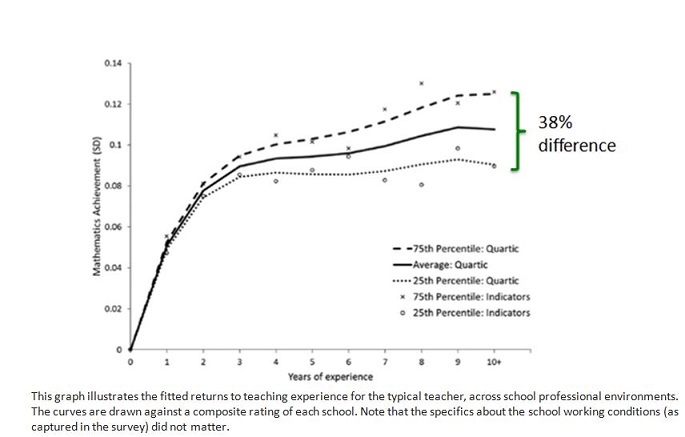Can schools make teachers more effective? In
thinking about that question, your mind probably goes to professional
development or other training activities. But Matthew Kraft and John Papay from Brown University took that query in a different direction, looking
at whether differences in school settings
make teachers more or less effective.
Combining student achievement data with
teachers’ responses to North Carolina’s biannual survey of working conditions, Kraft
and Papay investigated if teachers who worked in higher-rated Charlotte-Mecklenberg schools could
overcome the well-established pattern of poor returns to teaching experience—findings
repeatedly showing that growth in teacher effectiveness is limited largely to
the first few years of teaching.
And guess what? Working conditions do matter—at least in the Charlotte-Mecklenbergschool district. It stands to reason that teachers will
continue to grow and get increasingly effective in orderly buildings with
strong leadership and collaborative environments.
But it’s the magnitude of the difference that is
the real eye-opener. By the end of the first 10 years of a teacher’s career,
there’s a 38 percent gap in student achievement between a teacher at a highly-rated
school and a teacher at a low-rated school.

Unfortunately, the study doesn’t shed any
light on just what the ‘secret sauce’ is in the highly-rated schools, the
qualities about these schools that somehow make it easier for teachers to
continue to grow. The results were based on composite ratings; the specifics of
the working conditions as captured in the survey didn’t seem to matter. And we
can’t help but wonder which is the chicken and which is the egg: Do the working
conditions help teachers get better or does the presence of more effective
teachers impact the professional environment?
Furthermore, would these results hold in
another district, given that Charlotte-Mecklenburg
is well known for its turnaround efforts that have moved effective leaders and
teachers into high-needs schools?
Another recent study makes us think maybe
not.
Zeyu Xu, Umut Özek and Michael Hansen from the American Institutes for Research (AIR) looked at the effectiveness
of teachers who work in high-poverty schools versus those in low-poverty schools
(working paper available here). Tracking the performance of 4th
and 5th grade elementary teachers in North Carolina and Florida
at intervals over ten years, they found no systematic relationship between
schools’ poverty status and teacher performance.
Of course, poverty is a very imperfect proxy
for the working conditions explored by Kraft and Papay above; there are no
doubt high-needs schools that would score well on a teacher survey and
lower-needs schools that teachers would rate poorly. But were Kraft and Papay’s
findings to be generalizable, we’d expect to see some sort of relationship in
the AIR study.
It just may be that the secret sauce is a Charlotte-Mecklenburg local recipe, but
one certainly meriting a closer look.

